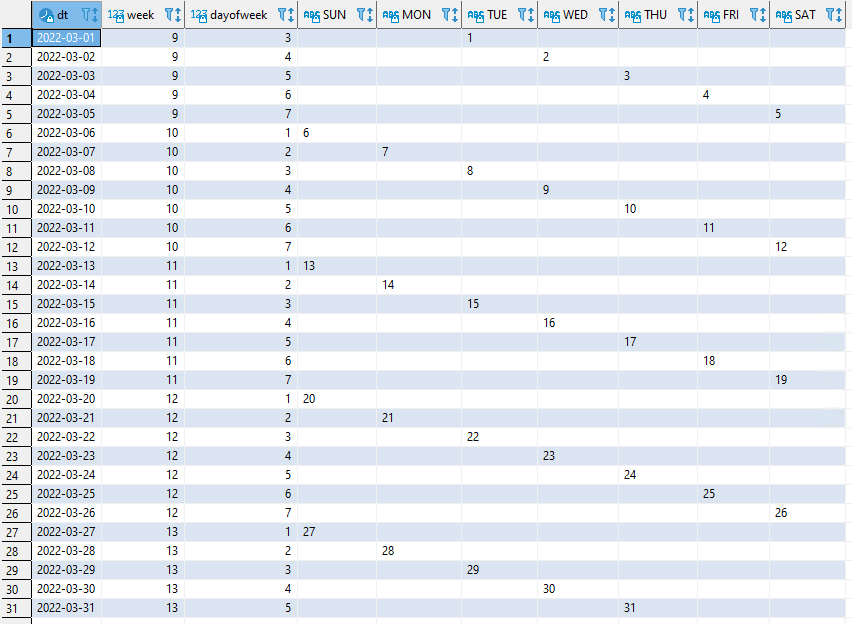曾經閑得無聊用 SQL (MySQL & Oracle) 製作過月曆。分享一下這個小作品吧。效果圖如下:

初見或許難以想像其製作過程,但其實相當簡易,僅需用 MySQL 寫約二十行程式碼即可完成。
1
2
3
4
5
6
7
8
9
10
11
12
13
14
15
16
17
18
|
with recursive seq (dt) as (
select last_day(curdate() - interval 1 month) + interval 1 day as dt
union all
select seq.dt + interval 1 day
from seq
where seq.dt < last_day(curdate())
)
select
max(case when dayofweek(dt) = 1 then dayofmonth(dt) else '' end) as SUN,
max(case when dayofweek(dt) = 2 then dayofmonth(dt) else '' end) as MON,
max(case when dayofweek(dt) = 3 then dayofmonth(dt) else '' end) as TUE,
max(case when dayofweek(dt) = 4 then dayofmonth(dt) else '' end) as WED,
max(case when dayofweek(dt) = 5 then dayofmonth(dt) else '' end) as THU,
max(case when dayofweek(dt) = 6 then dayofmonth(dt) else '' end) as FRI,
max(case when dayofweek(dt) = 7 then dayofmonth(dt) else '' end) as SAT
from seq
group by week(seq.dt, 0)
;
|
我也曾用 Oracle 寫過,但遺憾地丟失了。然而,基於這樣的思維,不同的 DBMS 都可以實現。我寫 SQL 的時候,通常優先遵從 ANSI Standard,以便在需要時,能較簡單地在其他 DBMS 上重現。
以上的 Query 主要分為兩步驟:
1. 建立數列 1, 2, 3, 4, 5 ...
這是 Recursive CTE 的經典用法,且符合 ANSI Standard,因此我選擇採用。但要注意你所使用的 DBMS 版本是否支援,例如 MySQL 需要版本 ≥ 8.0,Oracle 需要版本 ≥ 11gR2。
如果不支援,可以選擇其他方法,例如 Oracle 可以用 connect by,PostgreSQL 可以用 generate_series()。
只要能得到連續數列,就能輕易地轉換為日期序列。日子 + 1, 2, 3, 4, 5 ... 日,即可轉換為日期序列。
1
2
3
4
5
6
7
8
9
10
|
with recursive seq (dt) as (
select last_day(curdate() - interval 1 month) + interval 1 day as dt
union all
select seq.dt + interval '1' day
from seq
where seq.dt < last_day(curdate())
)
select *
from seq
;
|

2. 行列轉換
利用 CASE 來建立新的 columns,表示星期 日, 一, 二 ... 六。使用 function dayofweek(dt) 來獲得星期幾,並檢查是否與 column 名稱相符。若相符,value 則是日子 dayofmonth(dt),否則就為 NULL(為了美觀,我使用了空字串 '')。
若你覺得我解釋得不夠清楚,可以稍微修改 Query 並重新截圖。
這是 group by 前的情況:
1
2
3
4
5
6
7
8
9
10
11
12
13
14
15
16
17
18
19
|
with recursive seq (dt) as (
select last_day(curdate() - interval 1 month) + interval 1 day as dt
union all
select seq.dt + interval '1' day
from seq
where seq.dt < last_day(curdate())
)
select dt,
week(dt, 0) as `week`,
dayofweek(dt) as `dayofweek`,
case when dayofweek(dt) = 1 then dayofmonth(dt) else '' end as SUN,
case when dayofweek(dt) = 2 then dayofmonth(dt) else '' end as MON,
case when dayofweek(dt) = 3 then dayofmonth(dt) else '' end as TUE,
case when dayofweek(dt) = 4 then dayofmonth(dt) else '' end as WED,
case when dayofweek(dt) = 5 then dayofmonth(dt) else '' end as THU,
case when dayofweek(dt) = 6 then dayofmonth(dt) else '' end as FRI,
case when dayofweek(dt) = 7 then dayofmonth(dt) else '' end as SAT
from seq
;
|

如上所示,week() 可以得知該日是一年內的第幾週(我們需要的主要特性是「同一週的日期會得到相同的數值」!)
在同一個 week() 中,最多只有一個星期日、星期一、星期二……等。如果我們 group by week(),那麼像上圖的前五行,都是 week = 9,就會合併成一行。
再選擇適當的聚合函數,這裡我使用了 max(),例如 column TUE 經過 max(1, ‘’, ‘’, ‘’, ‘’) ⇒ 1。
最後,就完成了我們想要的月曆。

雖然製作月曆的實用性不高,但我認為以上提到的兩點都是做 SQL 報表或資料倉儲的重要技巧。
如果你有興趣,也可以嘗試改進上述的 SQL,例如簡化 SQL,或將當日(執行 SQL 的日期)以星號 * 標示。



